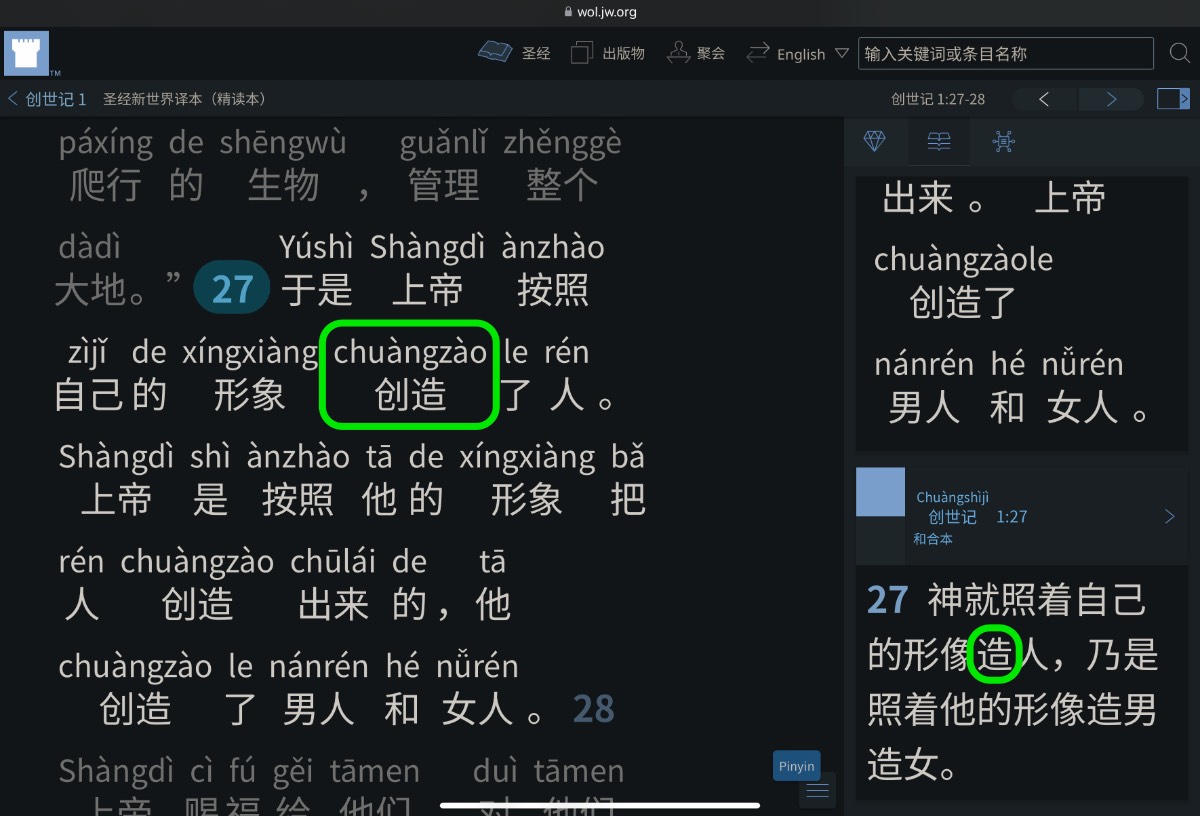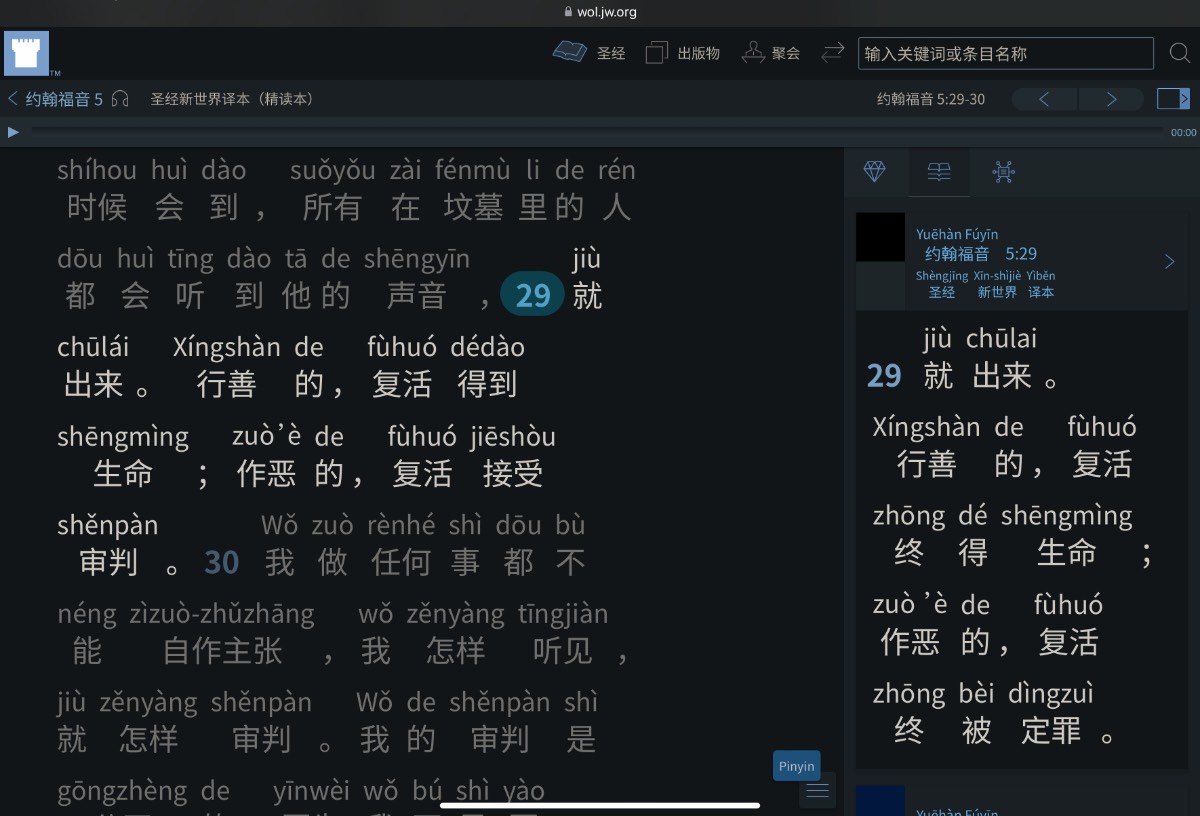shēn (body → [self] 身)‐lín ({being present (in)} 临 臨)‐qí (his/her/its/their… 其)‐jìng ({(set of) boundaries → [(bounded) place; area] → [condition; situation; circumstances]} 境) ← Tap/click to show/hide the “flashcard”
[Notes: Tap/click on a Pīnyīn (Pīn·yīn {Piecing Together of} · Sounds → [Pinyin] 拼音) expression to reveal its “flashcard”; tap/click on a “flashcard” or its Pīnyīn (Pīn·yīn {Piecing Together of} · Sounds → [Pinyin] 拼音) expression to hide the “flashcard”. 📖 📄 📘 icons mean 📖 Reveal All, 📄 Reveal Advanced, and 📘 Reveal None re all the “flashcards” in the heading, paragraph, etc. that they are placed at the beginning of.]
One of the publications that is now recommended to be used on Bible studies is the Yǒngyuǎn Xiǎngshòu Měihǎo de Shēngmìng—Hùdòng Shì Shèngjīng Kèchéng ((Yǒng·yuǎn Eternally · {Far (in Time)} 永远 永遠) (Xiǎng·shòu Enjoy · Receive 享受) (Měi·hǎo Beautiful · Good 美好) (de ’s 的) (Shēngmìng Life 生命)—(Hù·dòng {Each Other} · Moving → [Interactive] 互动 互動) (Shì (Type 式) (Shèng·jīng Holy · Scriptures → [Bible] 圣经 聖經) (Kè·chéng Lessons · Procedure → [Course] 课程 課程) → [Enjoy Life Forever!—An Interactive Bible Course (lff)]) (Enjoy Life Forever! (lff)) book. An outstanding feature of this book is its extensive use of the post-paper technology of video, which enables information to be presented much more vividly than could be done with paper. Also, at this time, one of the unique features of Pīnyīn (Pīn·yīn {Piecing Together of} · Sounds → [Pinyin] 拼音) Plus material is Pīnyīn (Pīn·yīn {Piecing Together of} · Sounds → [Pinyin] 拼音) Plus video transcripts. These can help us Mandarin field language learners to analyze and understand the Mandarin speech used in the many videos referenced in the Mandarin Enjoy Life Forever! book. This in turn can help us make more effective use of these videos while participating in Mandarin Bible discussions using this book.
This week’s MEotW, “shēn (body → [self] 身)‐lín ({being present (in)} 临 臨)‐qí (his/her/its/their… 其)‐jìng ({(set of) boundaries → [(bounded) place; area] → [condition; situation; circumstances]} 境)”, occurs in subtitle 35 of the transcript for the video for lesson 11, point 4 of the Mandarin Enjoy Life Forever! book:
English:
My favourite Bible book is Esther.
And because I think she was a very special person,
it was especially then that I could imagine
what her situation was like and what kind of a person she was
and I could see myself in the account.
Mandarin:
32
00:01:15,309 → 00:01:18,187
📖 📄 📘 Wǒ (I 我) zuì (most 最 最/㝡) xǐhuan (xǐ·huan like · enjoy 喜欢 喜歡) de ({’s (Bible book)} 的) shì (is 是) Yǐsītiējì (Yǐsītiē·jì Esther · Record → [Esther] 以斯帖记 以斯帖記).33
00:01:18,187 → 00:01:21,357
📖 📄 📘 Yīnwei (Yīn·wei because · for 因为 因為) wǒ (I 我) juéde (jué·de {to wake to → [to feel]} · get → [get to feel] 觉得 覺得) Yǐsītiē (Esther 以斯帖) hěn ({very much} 很) yǔ‐zhòng‐bùtóng ((yǔ with 与 與/与)‐(zhòng crowd 众 眾/衆)‐(bùtóng not · {was the same} → [was different] 不同) → [stood out from the crowd]),34
00:01:21,357 → 00:01:23,901
📖 📄 📘 suǒyǐ (suǒ·yǐ {that which} · {is the reason} → [so] 所以) zài (at 在) dú ({(I) read} 读 讀) zhèige (zhèi·ge this · [mw] 这个 這個) jìzǎi (jì·zǎi recorded · writing → [account] 记载 記載) de (’s 的) shíhou ({(particular) times} 时候 時候),35
00:01:23,901 → 00:01:26,696
📖 📄 📘 wǒ (I 我) gèng (more 更) róngyì (róng·yì {containing → [allowing]} · {being easy} → [easily] 容易) shēn (body → [self] 身)‐lín ({being present (in)} 临 臨)‐qí (her 其)‐jìng ({(set of) boundaries → [(bounded) place] → [situation]} 境) de ({in that way} 地) xiǎngxiàng (xiǎng·xiàng {think of} · {(instances of) being like → [images]} → [imagine] 想象 想象/像)36
00:01:26,696 → 00:01:28,782
📖 📄 📘 dāngshí (dāng·shí {at that} · {(particular) time} 当时 當時) tā (she 她) suǒ ({that which (she)} 所) chǔ ({was dwelling in} → [was situated in] 处 處) de (’s 的) huánjìng (huán·jìng surrounding · {(set of) boundaries → [(bounded) place] → [situation]} → [situation] 环境 環境),37
00:01:28,782 → 00:01:30,867
📖 📄 📘 háiyǒu (hái·yǒu also · {(there) is having → [(there) is]} 还有 還有) tā (she 她) shì (was 是) ge ([mw] 个 個/个) zěnyàng (zěn·yàng what · kind 怎样 怎樣) de (’s 的) rén (person 人).
Morphemic Breakdown
In “shēn (body → [self] 身)‐lín ({being present (in)} 临 臨)‐qí (his/her/its/their… 其)‐jìng ({(set of) boundaries → [(bounded) place; area] → [condition; situation; circumstances]} 境)”, “shēn (body [→ [self]] 身)”, which literally means “body”, is used to effectively mean “self”. Another Mandarin expression in which “shēn (body [→ [self]] 身)” is used this way is “xiànshēn (xiàn·shēn {offer → [dedicate]} · {body → [self]} | {offering of → [dedicating of]} · {body → [self]} → [dedication] 献身 獻身)”, which literally means “offer body”, but which effectively means “dedicate self”, as one does before getting baptized.
The “lín (face; overlook; {be near to} | arrive; {be present} | approach; {draw near} | {on the point of}; {just before}; {[be] about to} 临 臨)” in this week’s MEotW can have several possible meanings, as can be seen from its Pīnyīn (Pīn·yīn {Piecing Together of} · Sounds → [Pinyin] 拼音) Plus “flashcard”. In the context of “shēn (body → [self] 身)‐lín ({being present (in)} 临 臨)‐qí (his/her/its/their… 其)‐jìng ({(set of) boundaries → [(bounded) place; area] → [condition; situation; circumstances]} 境)”, “lín (face; overlook; {be near to} | arrive; {be present} | approach; {draw near} | {on the point of}; {just before}; {[be] about to} 临 臨)” evidently means “being present (in)”.
Long-time Mandarin field language learners may recall that this “lín (face; overlook; {be near to} | arrive; {be present} | approach; {draw near} | {on the point of}; {just before}; {[be] about to} 临 臨)” also appears in the expression “línzài (lín·zài {having arrived} · {being present} 临在 臨在)”, which was used in older versions of the Mandarin New World Translation Bible to translate the Greek word pa·rou·siʹa in scriptures such as Matthew 24:3. However, as explained in Appendix A2 of the current version of the Mandarin NWT Bible, “línzài (lín·zài {having arrived} · {being present} 临在 臨在)” is no longer used to translate pa·rou·siʹa because many readers found this Mandarin expression to be unfamiliar—indeed, out of the several dictionaries loaded in my Pleco app, this expression only appears in the Referenced Theo. Expressions (RTE) one.
Moving on to “qí (he/she/it/they/his/her/its/their/that/such… 其)”, this morpheme seems to function in “shēn (body → [self] 身)‐lín ({being present (in)} 临 臨)‐qí (his/her/its/their… 其)‐jìng ({(set of) boundaries → [(bounded) place; area] → [condition; situation; circumstances]} 境)” as a possessive determiner, determiners being a part of speech that many modern grammar theorists see as distinct from adjectives, pronouns, etc. Regarding that, Wikipedia provides this summary:
Most determiners have been traditionally classed either as adjectives or pronouns, and this still occurs in traditional grammars: for example, demonstrative and possessive determiners are sometimes described as demonstrative adjectives and possessive adjectives or as (adjectival) demonstrative pronouns and (adjectival) possessive pronouns respectively. …However, modern theorists of grammar tend to distinguish determiners as a separate word class from adjectives, which are simple modifiers of nouns, expressing attributes of the thing referred to.[source][source] This distinction applies particularly in languages, such as English, that use definite and indefinite articles frequently as a necessary component of noun phrases—the determiners may then be taken to be a class of words that includes the articles as well as other words that function in the place of articles.
Finally, the “jìng ({[(set of)] boundaries; borders} [→ [[(bounded)] place; area; territory] [→ [condition; situation; circumstances]]] 境)” in “shēn (body → [self] 身)‐lín ({being present (in)} 临 臨)‐qí (his/her/its/their… 其)‐jìng ({(set of) boundaries → [(bounded) place; area] → [condition; situation; circumstances]} 境)” literally means “boundaries; borders”, which here effectively means “(set of) boundaries”, which in turn effectively means “(bounded) place; area”, which in turn effectively means “condition; situation; circumstances”. Another expression in which this “jìng ({[(set of)] boundaries; borders} [→ [[(bounded)] place; area; territory] [→ [condition; situation; circumstances]]] 境)” appears is “huánjìng (huán·jìng surrounding; encircling · {(set of) boundaries → [(bounded) place; area] → [condition; situation; circumstances]} → [environment; surroundings; circumstances; situation; context | environmental] 环境 環境)”, which appears in subtitle 36 of the above Pīnyīn (Pīn·yīn {Piecing Together of} · Sounds → [Pinyin] 拼音) Plus video transcript excerpt.
Non-“Standard” Hyphenation?
Four-syllable/character expressions like “shēn (body → [self] 身)‐lín ({being present (in)} 临 臨)‐qí (his/her/its/their… 其)‐jìng ({(set of) boundaries → [(bounded) place; area] → [condition; situation; circumstances]} 境)” have often been written in Pīnyīn (Pīn·yīn {Piecing Together of} · Sounds → [Pinyin] 拼音) with a hyphen between the middle syllables, or as one whole word. These formats are really just general stylistic conventions, since even the PRC government’s official standard for Pīnyīn (Pīn·yīn {Piecing Together of} · Sounds → [Pinyin] 拼音) orthography is at most a set of recommendations.
Pīnyīn (Pīn·yīn {Piecing Together of} · Sounds → [Pinyin] 拼音) Plus material renders such multi-morpheme expressions with hyphens at the actual word boundaries, which should make it easy for readers to parse how these expressions are constructed and thus make sense of them.
Just Like Being There
Interestingly, while it’s obviously relatively easy to get immersed in a good video, with its sights and sounds, the sister quoted in the above-mentioned video from the Enjoy Life Forever! book said that the Bible’s true-life written account about Esther was so compelling to her that she could see herself being there. This week’s MEotW can help us to talk with our Mandarin-speaking Bible students about that kind of Bible-reading experience.
For convenience:
The direct link for the Pīnyīn (Pīn·yīn {Piecing Together of} · Sounds → [Pinyin] 拼音) Plus resource for the Enjoy Life Forever! book is:
The short link for Chinese field language-learning links for the Enjoy Life Forever! book is:
More Pīnyīn (Pīn·yīn {Piecing Together of} · Sounds → [Pinyin] 拼音) and Pīnyīn (Pīn·yīn {Piecing Together of} · Sounds → [Pinyin] 拼音) Plus web material based on the Mandarin Enjoy Life Forever! book will be made available in the Pīnyīn (Pīn·yīn {Piecing Together of} · Sounds → [Pinyin] 拼音) Plus web resource as time allows.

